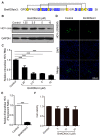Inhibitory Activity of a Scorpion Defensin BmKDfsin3 against Hepatitis C Virus
- PMID: 31963532
- PMCID: PMC7168052
- DOI: 10.3390/antibiotics9010033
Inhibitory Activity of a Scorpion Defensin BmKDfsin3 against Hepatitis C Virus
Abstract
Hepatitis C virus (HCV) infection is a major worldwide health problem which can cause chronic hepatitis, liver fibrosis and hepatocellular carcinoma (HCC). There is still no vaccine to prevent HCV infection. Currently, the clinical treatment of HCV infection mainly relies on the use of direct-acting antivirals (DAAs) which are expensive and have side effects. Here, BmKDfsin3, a scorpion defensin from the venom of Mesobuthus martensii Karsch, is found to dose-dependently inhibit HCV infection at noncytotoxic concentrations and affect viral attachment and post-entry in HCV life cycle. Further experimental results show that BmKDfsin3 not only suppresses p38 mitogen-activated protein kinase (MAPK) activation of HCV-infected Huh7.5.1 cells, but also inhibits p38 activation of Huh7.5.1 cells stimulated by tumor necrosis factor-α (TNF-α), interleukin-1β (IL-1β) or lipopolysaccharide (LPS). BmKDfsin3 is also revealed to enter into cells. Using an upstream MyD88 dimerization inhibitor ST2345 or kinase IRAK-1/4 inhibitor I, the inhibition of p38 activation represses HCV replication in vitro. Taken together, a scorpion defensin BmKDfsin3 inhibits HCV replication, related to regulated p38 MAPK activation.
Keywords: Hepatitis C virus (HCV); p38; scorpion defensin.
Conflict of interest statement
The authors declare no competing financial interest.
Figures





Similar articles
-
Virucidal activity of oriental hornet Vespa orientalis venom against hepatitis C virus.J Venom Anim Toxins Incl Trop Dis. 2021 Nov 19;27:e20210039. doi: 10.1590/1678-9199-JVATITD-2021-0039. eCollection 2021. J Venom Anim Toxins Incl Trop Dis. 2021. PMID: 34868283 Free PMC article.
-
A Scorpion Defensin BmKDfsin4 Inhibits Hepatitis B Virus Replication in Vitro.Toxins (Basel). 2016 Apr 27;8(5):124. doi: 10.3390/toxins8050124. Toxins (Basel). 2016. PMID: 27128943 Free PMC article.
-
HoxA10 Facilitates SHP-1-Catalyzed Dephosphorylation of p38 MAPK/STAT3 To Repress Hepatitis B Virus Replication by a Feedback Regulatory Mechanism.J Virol. 2019 Mar 21;93(7):e01607-18. doi: 10.1128/JVI.01607-18. Print 2019 Apr 1. J Virol. 2019. PMID: 30674631 Free PMC article.
-
Hepatitis C Virus-Associated Cancers.Adv Exp Med Biol. 2017;1018:129-146. doi: 10.1007/978-981-10-5765-6_8. Adv Exp Med Biol. 2017. PMID: 29052135 Review.
-
Hepatitis C Virus Infection Induces Autophagy as a Prosurvival Mechanism to Alleviate Hepatic ER-Stress Response.Viruses. 2016 May 23;8(5):150. doi: 10.3390/v8050150. Viruses. 2016. PMID: 27223299 Free PMC article. Review.
Cited by
-
Potential for Protein Kinase Pharmacological Regulation in Flaviviridae Infections.Int J Mol Sci. 2020 Dec 15;21(24):9524. doi: 10.3390/ijms21249524. Int J Mol Sci. 2020. PMID: 33333737 Free PMC article. Review.
-
Alpha-defensins inhibit ERK/STAT3 signaling during monocyte-macrophage differentiation and impede macrophage function.Respir Res. 2023 Dec 11;24(1):309. doi: 10.1186/s12931-023-02605-0. Respir Res. 2023. PMID: 38082274 Free PMC article.
-
Antimicrobial Peptide Analogs From Scorpions: Modifications and Structure-Activity.Front Mol Biosci. 2022 May 26;9:887763. doi: 10.3389/fmolb.2022.887763. eCollection 2022. Front Mol Biosci. 2022. PMID: 35712354 Free PMC article. Review.
-
Peptides with Diverse Functions from Scorpion Venom: A Great Opportunity for the Treatment of a Wide Variety of Diseases.Iran Biomed J. 2023 Mar 1;27(2 & 3):84-99. doi: 10.61186/ibj.3863. Iran Biomed J. 2023. PMID: 37070616 Free PMC article.
-
The tick saliva peptide HIDfsin2 promotes the tick-borne virus SFTSV replication in vitro by enhancing p38 signal pathway.Arch Toxicol. 2023 Jun;97(6):1783-1794. doi: 10.1007/s00204-023-03515-2. Epub 2023 May 6. Arch Toxicol. 2023. PMID: 37148319 Free PMC article.
References
-
- Lei R., Hou J., Chen Q., Yuan W., Cheng B., Sun Y., Jin Y., Ge L., Ben-Sasson S.A., Chen J., et al. Self-assembling myristoylated human alpha-defensin 5 as a next-generation nanobiotics potentiates therapeutic efficacy in bacterial infection. ACS Nano. 2018;12:5284–5296. doi: 10.1021/acsnano.7b09109. - DOI - PubMed
LinkOut - more resources
Full Text Sources

